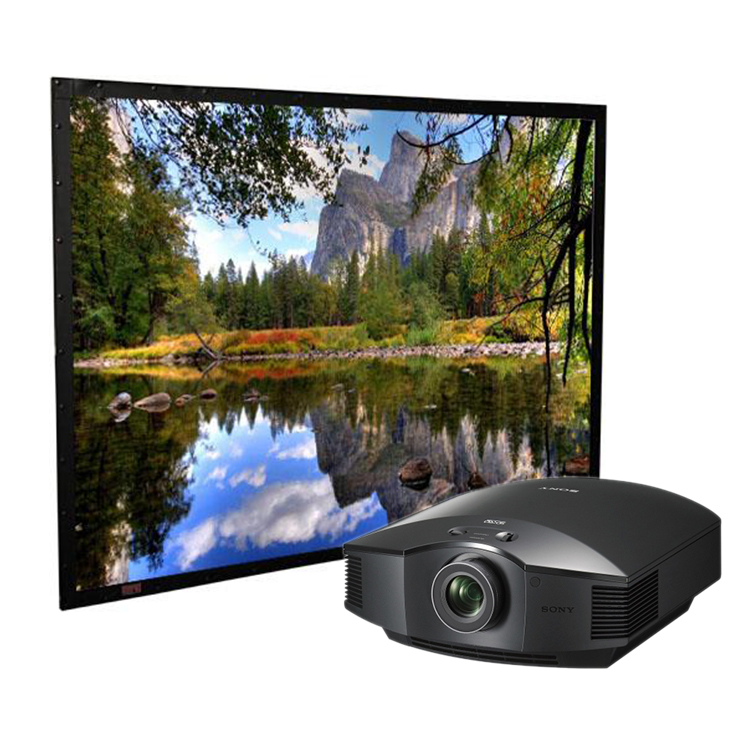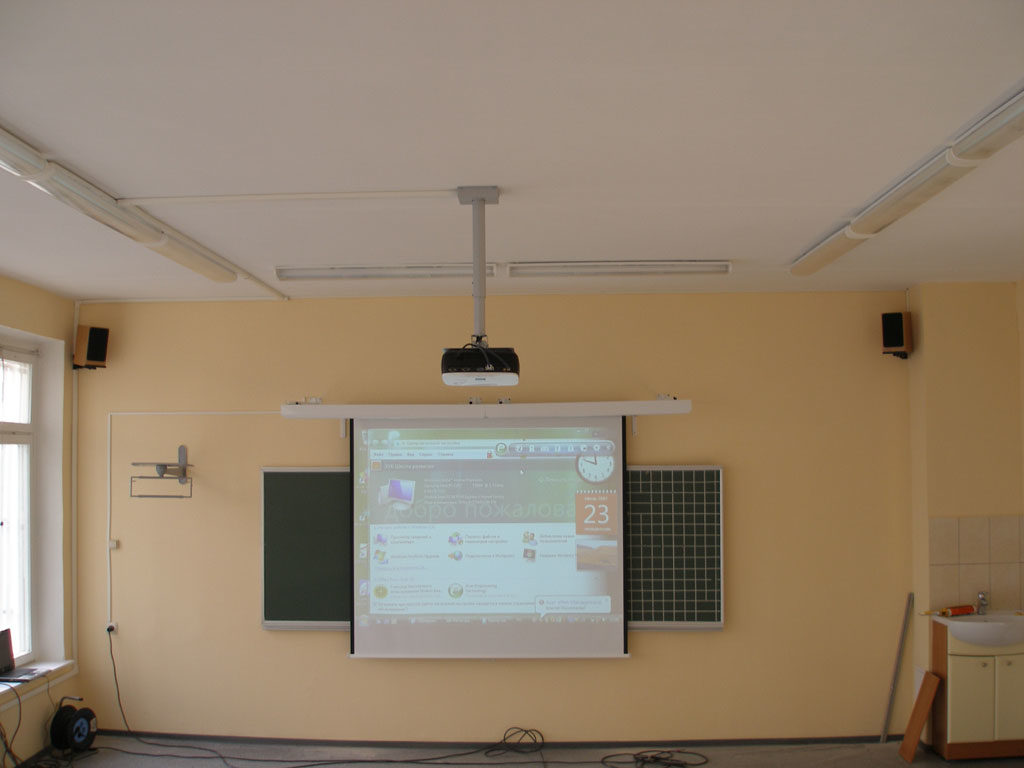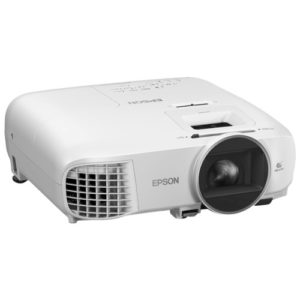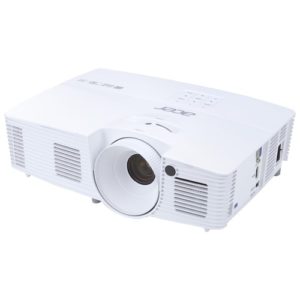Today, with the rapid development of technology in the school, the teacher does not need to prepare material for demonstration from improvised means, which is then hung on the walls and educational boards. A great help to them in this was the projector for the school, which is almost indispensable for conducting lessons. After all, a lot of visual material can be found on the Internet or done by yourself using various computer programs. How to choose a projector for the school to make the learning process the most effective?

Content
What is he like
This multimedia device, which performs the functions of projection equipment, contributes to the display of information on the screen. It can be transmitted from various sources, for example, from a DVD or a computer. If you use the projector in conjunction with interactive additions, for example, with a board, then it is possible to replace such an attribute in the class as the most functional.
Projector specifications required for use in schools
Consider the parameters of multimedia devices that may be important in the educational process.
- Matrix Resolution The most important properties of the mechanisms are brightness and graphic data projection. And the higher its resolution, the sharper the image. At the same time, the audience will not need ultra-high transmission for operation, broadcasting of projects, presentations and photo material will be quite high with parameters up to 1200 lumens.
- Display Standards. In educational institutions, as a rule, standard characteristics of 4x3 are used, and widescreen monitors 15: 9, 16: 9, 16:10 are suitable for schoolchildren to watch films. But to get a matching picture, it is better to use a monitor and a projector of the same format.
- Light flow. It should be borne in mind that the demonstration of images in the lesson is very often accompanied by additional activities (students can study the textbook or make notes in the notebook), so the room is rarely obscured. Accordingly, when light rays hit the screen, the picture will be practically invisible. In order to avoid this situation, you can darken a small area of the room located between the transmitting device and the screen. At the same time, there should not be special requirements for its brightness, from 600 to 1500 lumens will be enough for broadcast in the classroom.
- Color rendering. It is determined depending on the contrast of the transmitted material, formed by the matrix of the mechanism and the scheme of its dynamic increase. In this case, it is necessary to carefully believe the values declared by the manufacturer. It is better to pay attention to the largest statistical characteristics with the possibility of the dynamics of their changes. Models have now appeared that offer color brightness including red, blue, and green. They guarantee clear and accurate images.
- Connection to a network. It is possible to connect the device to the network via WI-FI and Enternet ports.
- Interfaces There are various types: analog, digital, etc., so it is better to choose with the support of all existing. But if it is used only in a classroom with a specific source, then it is possible to choose the support of a video card for a personal computer. If necessary, you can use additional devices, for example, splitters and adapters.
Projection Device Functionality
To work in a school setting, a minimum set of operations and capabilities is required. These include:
- remote control of the mechanism;
- image clarity and contrast adjustment;
- reflection of information in the horizontal and vertical direction;
- correction of inaccuracies in the picture;
- format change.
In addition, some models offer:
- interactive work;
- quick lens change;
- zoom function for a specific picture;
- frame stop;
- showing no more than two different images;
- various ports for viewing information without connecting to a PC;
- lens movement.
It should be noted that such a set of functions may not be in demand in the educational process.
Projector use in educational institutions
Given that this multimedia device is a universal means of displaying data with
different sources, he is able to cope with the replacement of the blackboard, with colored crayons, as well as with the work of drawing instruments. Consider ways to use it in education.
- Display training videos: documentary and animated. To do this, you need to connect it to the player. This is the simplest and most economical way to use the equipment, and its functionality will be minimized, since the whole process will consist of broadcast films or slides that will be commented by the teacher. For such an activity, there will be quite cheap projection systems with SVGA approval and component, composite and HDMI connectors. At the same time, it is worth taking care of the power of the existing speaker, since the video player does not include its own speakers.
- Broadcasting material from a personal computer device. With this use, it is possible to display texts, graphic images, pages from sites and build real technology by drawing on a laptop. In this case, the mechanism will be used as a large monitor. You will need a VGA or HDMI input.
- Connecting a projector to an interactive whiteboard. However, there are different options for their use:
- the most economical, but low-quality in use is a special scheme installed on one of the hard surfaces, for example, a blackboard, a wall, a writing board with a marker and another. Such a module monitors marker movements and copies them to a PC. Here, sensory transmission is very slow and inaccurate;
- interactive projection device. It is endowed with special measuring and control devices. When it is connected, no additional settings are required, and each plane can be converted into an interactive one. Basically, such devices function quite high quality, but still a slight suspension in action is manifested. The negative side of such a mechanism is its high cost;
- the most popular way to raise the level of schooling is to purchase equipment together. In this scheme, the projection device illuminates a specially created board that recognizes the activity of the manipulator and transmits its result for processing, where through special programs the information is processed and displayed in the equipment.

All variations of the use of the projector are aimed at interacting with information. It can be displayed on the screen, highlight a specific part, display tasks and immediately state their solution. In addition, objects can be moved and deployed in space, which seems very realistic.
It should be noted that interactive learning involves the use of short focus models. They project an image of a certain size from a short distance from the surface of the plane than their telephoto rivals.
On models with a standard distance between the lens and the screen, the length can be about two screen widths. It can be more if there is an interchangeable lens. The disadvantage is the location of the subject, processing the incoming material and shading it.
An extension with a short focus is obtained when displaying information and gives a proportion of 0.5: 1. In this case, the user of the mechanism does not drop the dimming to the screen level, and the visibility is excellent. But in this case, the device is connected to different sources that transmit data.
By the way, the advantage will be the presence of several ports.
The full-fledged operation of interactive devices directly depends on the level of specialized programs, the capabilities of which vary depending on their developers.
What to look for when choosing a projector for school
What to be guided by and what to evaluate first of all, choosing a projection mechanism for the needs of the school? Which projector is better for school?
- Savings in operation. Of course, the most important factor in acquiring a project for educational activities is its cheapness. But, in addition to this, not the last parameter is the economical use of the product throughout the entire period of its operation. Therefore, it is important to analyze the data of the lighting device, how much the lamp can work without its replacement and its price. On average, the resource of such a part can reach about five thousand hours, which can stretch for 5 years. In addition, if the projector often works in limited brightness mode, then the performance will be extended for a long time, which will protect it from premature change.
- Compliance with the interactive mode of boards. The compatibility of the projector and other optional equipment is very important. Devices with WXGA resolution work qualitatively, which expand the size of the perceptual surface, which enables students to improve the perception of information and learn the information presented in the lesson. Modern mechanisms are endowed with powerful loudspeakers, with which you can broadcast video materials without connecting extraneous speakers.
- Download speed. A necessary characteristic of a multimedia translator for a teacher is the speed of turning it on and off. The best option is to connect it to a PC with a single cable. In such a situation, it will be easy for the teacher to connect it without using the help of specialists. Most of the devices on the market do not take a huge amount of time to create a high-quality picture, which contributes to the rapid presentation of educational material. At the end of the work, it still takes time to cool the electronic parts and the lamp. But if it is based on technology in which a special shell design and a minimum heating temperature of the lighting device are provided, then it can be turned off instantly, which will not cause damage to it.
- Safety of use. When working with children, one should not forget about the protective functions of the device: it can be protection against abduction and use not related to its purpose. When purchasing a device, you need to find out the presence of connectors for locks and the possibility of entering with a password. In addition, models without any buttons that work from the remote control signal have already been released.
- Screen selection. Do not forget that the lack of a special screen will degrade the image quality many times, therefore, in addition to buying a projector, you need to choose a suitable surface. It can either be pulled on a special design, or wrapped in a roll, and mounted on a wall or ceiling. The most suitable option for the educational institution would be a product with a white matte surface.

So, choosing a device for school, you need to pay special attention to the quality of the transmitted image, its brightness, which depends on the area of the class. Projectors with 3LCD LCDs displaying excellent color are popular in schools. The format of the device must comply with the 4: 3 parameters. Built-in speakers are desirable.
Ask about the availability of warranty service and the availability of a service center. This is important when problems arise, especially with lamps, as often happens.
The best projectors for school
We present you the TOP 5 best projects for the school.
Ricoh PJ WXC4660


- LED backlight
- ultra short focus
- video inputs VGA, HDMI, USB, audio, LAN, etc.
- brightness 4000 lm
- noiselessness
- gives a large picture at close range
- high definition image
- convenient settings panel
- large dimensions
- High price
This ultra-short focus model rightfully takes first place in the ranking. It delivers a clear, huge 130 ”image from a distance of just 76 cm! At the same time, the picture has a resolution of 1280x800 pixels, with very good color reproduction. Any, even the smallest, details of the graphs will be clearly visible. The image is adjusted at 4 angles, the lens can be shifted or tilted up to 360 °.
Modern lamps light sources do not require replacement, they serve for 20,000 hours, providing brightness up to 4,000 lumens.
The device provides stereo sound without the need for additional speakers. However, there are 2 audio outputs available: Mini Jack 3.5 mm and RCA (R / L). The device displays information from a laptop or flash drive, and the shadow from a standing person will not darken the image due to ultra-short focus.
2 HDMI sockets plus 2 VGA slots allow to connect various types of video devices. The Ricoh PJ WXC4660 is the ideal multi-function projector for an ultra-short focus school.
BenQ MX631ST

- resolution 1024x768 px
- 3D image
- VGA, HDMI inputs
- 2 USB ports
- Projection Ratio 0.9: 1
- no lens adjustments
This projector has a stylish design, convenient mount and not bad lamps with a luminous flux of 3,200 lm. The resource is 4,000 hours in normal mode and up to 10,000 hours in economic mode. The device reproduces not only the image, but also the sound.
The device is portable, it weighs only 2.6 kg, but you can get a bright and clear picture only in dim light. In addition, to achieve a large diagonal of the image without loss of quality will be possible only when the projector is placed at a distance of 3-5 m from the screen.
You can only adjust the lens manually. The model should be used only in rooms of suitable length.
Epson EH-TW5400

- 3 LCD lamps
- 1920 × 1080p
- VGA, HDMI, USB ports
- 1.22: 1 projection ratio
- luminous flux 2,500 lm
This model plays only photos from a USB drive, and video from a tablet or PC. The projector displays an image in Full HD. However, the luminous flux power is not enough to clearly reproduce the picture in a well-lit room, so the projector is only suitable for classrooms with shutters or dark curtains.
The projector has a soundtrack - there is a speaker with a power of 10 watts, but the sound is rather weak. It can make a lot of noise when working. Lamps in ECO mode give lighting 1,650 lm, and serve up to 7,500 h; with improved brightness, the resource is reduced to 4,500 hours.
Viewsonic PA503W

- weight 2.2 kg
- 3D pictures
- excellent image quality
- high contrast, sharpness
- 3 600 lm lamp
- projection ratio 1.55: 1
- lamps flicker
- no speakers
This projector in a white case gives a good picture from flash drives, good quality video via VGA or HDMI cable. The difference from other rating models is the lack of speakers. In bright operation, a fan is heard. But the model is characterized by an intense light flux, which allows you to efficiently operate the device even in bright natural light.
But after a while, many users get a lamp error - they turn off and have to be replaced. It is worth considering this factor, although this does not always happen. The minimum distance for high-quality projection is 1 m.
The package includes a remote control along with batteries, a VGA cable, detailed installation and configuration instructions. The model is also suitable for home use.
Acer H6517ABD

- design
- P-VIP lamp for 3 400 lm
- weight 2.5 kg
- convenient control
- resource 5 000 hours
- 3w speaker
- not adjustable tilt and rotation of the lens
- one HDMI input
- no image angle settings
The projector is designed for high-quality and comfortable demonstration of images in front of an audience. It can be used in small conference rooms, schools and other educational institutions, in offices and at home.
The device has one input VGA, HDMI, audio mini jack and audio mini USB. The image is clear, the colors are juicy even in daylight. But there is a significant minus - the projector needs to be hung directly opposite the board, since the corners of the picture are not adjustable.
Three holes are reserved for the mount, so most standard fasteners will not work. The device is equipped with speakers, the total power of which is 3 watts. This is not enough for comfortable listening even in class, so the sound will have to be connected separately.